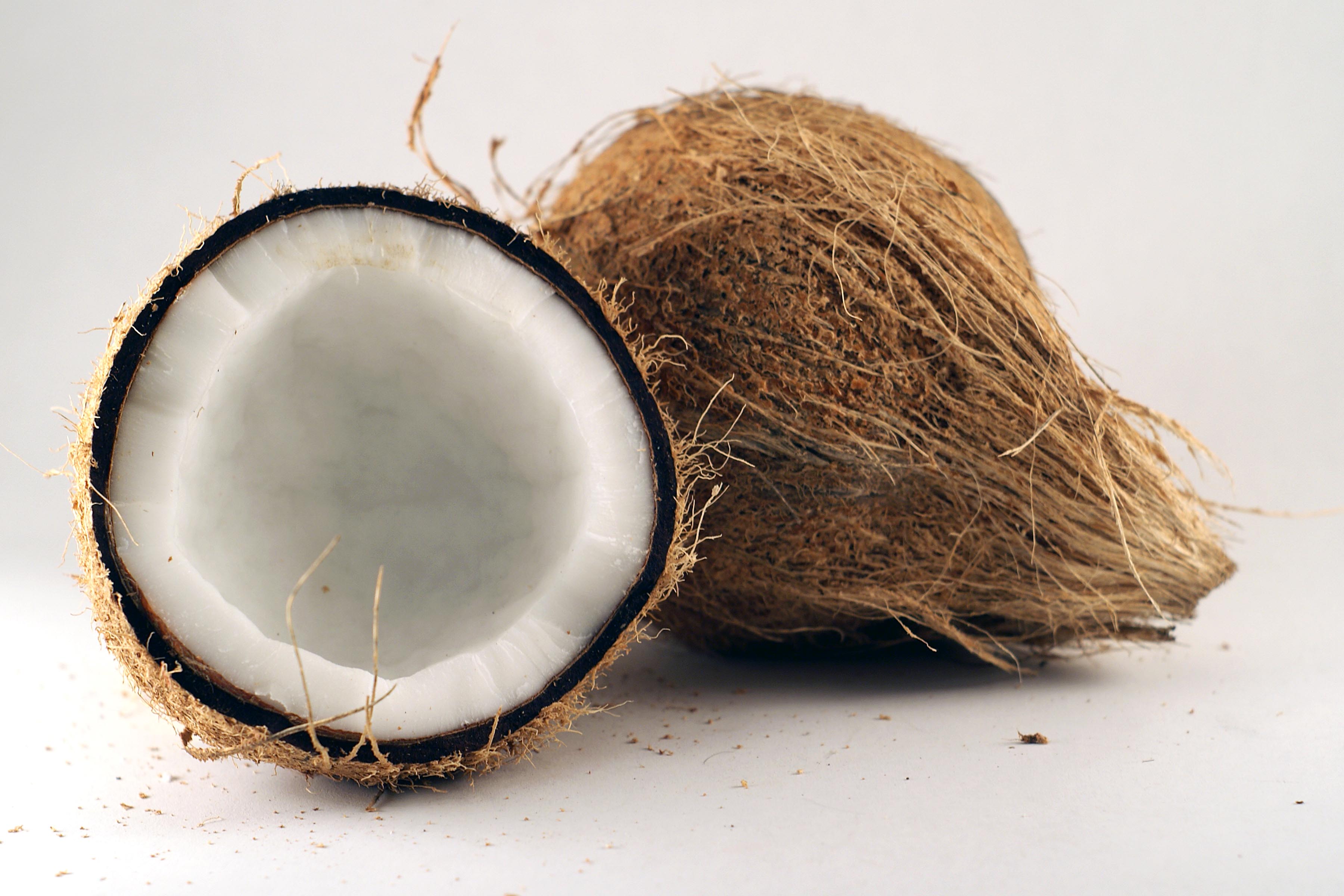Kookospähkinä on kovin kiistanalainen hedelmä sen tyydyttyneiden rasvahappojen takia. Selvennetään hieman, miksi kookospähkinää kannattaa syödä.
Kookospähkinän ravintosisältö (/100g) ja bioaktiiviset ainesosat mm:
Energia 354 kcal
Hiilihydraatti 15.23g
Proteiini 3.3g
Rasva 33.49g
Ravintokuitu 9.0g
Kookosöljyn rasvahappokoostumus
Tyydyttyneet rasvahapot 92.1%, joista:
Lyhytketjuiset rasvahapot:
Kapronihappo (C-6) 0.5%
Keskipitkäketjuiset rasvahapot, joista:
Kapryylihappo (C-8) 8%
Kapriinihappo (C-10) 10%
Lauriinihappo (C-12) 48%
Pitkäketjuiset rasvahapot, joista:
Myristiinihappo (C-14) 17%
Palmitiinihappo (C-16) 9%
Steariinihappo (C-18) 2%
Linoleenihappo (C-18) 2.1% (monityydyttynyt rasvahappo 2.1%)
Tyydyttymättömät rasvahapot 6.2%:
Öljyhappo (C-18) 6.2% (kertatyydyttymätön rasvahappo)
Kookosvesi sisältää (/100g) mm.
Rauta 2,43mg
Kalsium 14mg
Magnesium 32mg
Fosfori 113mg
Kalium 356mg
Sinkki 1,1mg
C-vitamiini 3,3mg
B1-vitamiini 0,066mg
B2-vitamiini 0,02mg
B3-vitamiini 0,54mg
B5-vitamiini 0,0mg
B6-vitamiini 0,054mg
Rasvahapot voi luokitella kahdella eri tavalla kolmeen eri luokkaan. Perinteisin tapa on jaotella rasvat tyydyttyneisiin, kertatyydyttymättömiin ja monityydyttymättömiin rasvahappoihin. Tyydyttyneitä rasvahappoja kutsutaan myös koviksi rasvoiksi. Nimensä mukaisesti nämä rasvat ovat siis kiinteitä huoneenlämmössä. Runsaita tyydyttyneiden rasvojen lähteitä ovat mm. rasvaiset liha- ja maitotuotteet sekä leivonnaiset. Tyydyttyneet rasvahapot lisäävät veren huonon kolesterolin arvoja ja täten lisäävät sydänsairausten riskiä. Tyydyttyneitä ja transrasvoja tulisi olla ruokavaliossa alle 10E% päivittäisestä rasvojen kokonaisenergiasaannista.
Kookospähkinästä lähes 60E% on tyydyttyneitä rasvahappoja mutta kookospähkinä on siitä erikoinen, että sen rasvat ovat lähinnä keskipitkäketjuisia.
Rasvat voi jaotella myös hiiliketjunsa mukaan lyhytketjuisiin, keskipitkäketjuisiin ja pitkäketjuisiin rasvahappoihin. Keskipitkät rasvahapot ovat erinomainen energianlähde, koska ne sulavat ja imeytyvät hetkessä raviten kehoa nopeasti. Toisin kuin muut rasvat, nämä rasittavat ruoansulatuselimistöä hyvin vähän ja edistävät terveyttä. Lyhytketjuiset ja keskipitkäketjuiset rasvahapot imeytyvät suoraan ohutsuolen onteloa reunustaviin epiteelisoluihin ja tätä kautta verenkiertoon. Lyhyempiketjuiset rasvahapot vaativat täten vähemmän energiaa ja entsyymejä ruoansulatukselta.
Muita kookoksen terveysvaikutuksia:
- parantaa ruuansulatusta ja rasvaliukoisten vitamiinien ja aminohappojen imeytymistä
- tukee immunijärjestelmän toimintaa ja taistelee viruksia, bakteereita ja sieniä vastaan
- edistää kalsiumin ja magnesiumin imeytymistä
- toimii voimakkaana antioksidanttina
- tukee hormonitoimintaa ja sen säätelyä
- kiihdyttää kilpirauhasen toimintaa, mikä on hyväksi kilpirauhasen vajaatoiminnasta kärsiville
- kookosöljy sisältää painoonsa nähden vähemmän kaloreita kuin mikään muu rasva, eikä kookosöljy varastoidu kehoomme samalla tavalla kuin muut rasvat
- keskipitkäketjuiset rasvahapot kiihdyttävät aineenvaihduntaa ja tukevat täten painon pudottamisessa.
- kookosöljy ei sisällä kolesterolia ja se itseasiassa tukee sydämen- ja verisuonten terveyttä. Toisaalta kookosöljy tukee terveellisen kolesterolin (HDL) muodostumista maksassa.
- kookosöljy hapettuu vasta 92 asteessa.
----------------------------------------------------------------------------------------------------
----------------------------------------------------------------------------------------------------
----------------------------------------------------------------------------------------------------
----------------------------------------------------------------------------------------------------
Coconut is a very controversial fruit because of it's saturated fats. Let me clarify a bit why eating coconut is a very good thing.
Coconut nutritional content (/100g) and bio-active ingredients include:
Energy 354 kcal
Carbohydrate 15.23g
Protein 3.3g
Fat 33.49g
Dietary Fiber 9.0g
Coconut oil fatty acid composition
Saturated fatty acids 92.1%, of which:
Short-chain fatty acids:
Caproic acid (C- 6) 0.5%
Medium-chain fatty acids, of which:
Caprylic acid (C 8) 8%
Capric acid (C- 10) to 10%
Lauric acid (C 12) 48%
Long-chain fatty acids, of which:
Myristic acid (C 14) 17%
Palmitic acid (C-16) 9%
Stearic acid (C 18) 2%
Linolenic acid (C 18) 2.1% (polyunsaturated fatty acid 2.1%)
Unsaturated fatty acids 6.2%
Oleic acid (C 18) 6.2 % (monounsaturated fatty acid)
Coconut water contains (/100g)
Iron 2.43 mg
calcium 14mg
magnesium 32mg
phosphorus 113mg
potassium 356mg
Zinc 1.1mg
Vitamin C 3.3mg
Vitamin B1 0.066mg
Vitamin B2 0.02mg
Vitamin B3 0.54mg
Vitamin B5 0.0mg
Vitamin B6 0.054mg
The fatty acids can be classified in two different ways in three categories. The most traditional way to categorize fats is to divide them into saturated, monounsaturated and polyunsaturated fatty acids. Saturated fats are solid at room temperature. Food sources with high quantities of saturated fat includes fatty meats and dairy products as well as baked goods. Saturated fats increase bad cholesterol in the blood, and thus increase the risk of heart disease. The daily intake of saturated and trans fats should be less than 10E% of the total daily fat intake.
Coconut contains nearly 60E% saturated fatty acids but what makes the fruit so special is that those are mainly medium-chain fats.
Fats can also be divided based on their carbon chain to short-chain, medium-chain and long-chain fatty acids. Medium-chain fatty acids are an excellent source of energy because they are digested and absorbed instantly nourishing your body. Unlike other fats, they strain the digestive system very little and promote health. Short-chain and medium-chain fatty acids are absorbed directly through the small intestine to the bloodstream. Therefore shorter chain fatty acids require less energy and enzymes for digestion.
Other health benefits of coconut:
- improves digestion and the absorption of fat-soluble vitamins and amino acids
- supports the immune system function, fights viruses, bacteria and fungi
- promotes the absorption of calcium and magnesium
- acts as a powerful antioxidant
- supports the endocrine system and its regulation
- stimulates thyroid function, which is good for people with hypothyroidism
- coconut oil has fewer calories and it is stored in our bodies differently than any other fat
- medium-chain fatty acids stimulate metabolism and therefore support weight loss.
- coconut oil contains no cholesterol and, in fact, it supports cardiovascular health. On the other hand coconut oil supports healthy cholesterol (HDL) formation in the liver.
- coconut oil is oxidized 92 degrees Celsius.
----------------------------------------------------------------------------------------------------
References:
Liikuntaravitsemus, VK-Kustannus Oy, 2006
www.livestrong.com/article/402018-what-are-the-health-benefits-of-coconuts-coconut-oil/
www.livestrong.com/article/281682-unsweetened-coconut-flakes-nutrition/
www.coconutresearchcenter.org/article10612.htm
www.meltorganic.com/what-are-medium-chain-fatty-acids-and-why-are-they-important-to-your-health/
www.kookosravinto.fi/virilo/virilo-neitsytkookosoljy/tieteellista-tutkimusta/69
sundqvist.blogspot.fi/2009/07/keskipitkat-rasvahapot-saattavat.html
superfoodit.com/kookostuotteet/
www.helsinkipaleo.com/2011/09/helsinki-paleon-rasvaopas/






